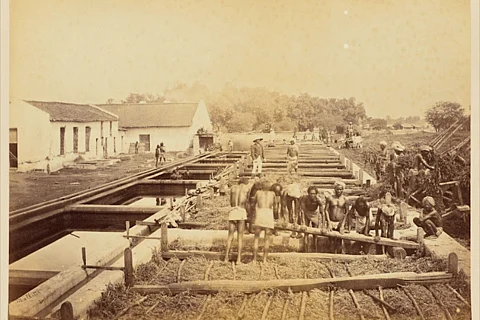
- HOMEGROWN WORLD
- #HGCREATORS
- #HGEXPLORE
- #HGVOICES
- #HGSHOP
- CAREERS
- ABOUT US
- CONTACT US

While today you’ll find a pair of blue jeans in virtually every closet, there was a time when indigo, the pigment used in denim, was one of the most sought-after products in the world. Referred to as "blue gold", the pigment was once one of India’s most valuable exports, which also made it one of our most treacherous. India first started producing indigo over 5,000 years ago. The Indigofera plant, found along the East and South of India, was soaked in water, fermented, oxidised, and processed to create a rich blue pigment. Although we now have synthetic versions of indigo dye at our disposal, for centuries, the Indigofera plant was our only avenue to achieving such a vibrant colour.
So, naturally, when the British colonised India, they were in fierce pursuit of indigo for their textile industry. In need of the Indigofera plant, the East India Company coerced peasant farmers across Bihar and Bengal by offering them advanced payments to rent land for indigo production instead of growing crops like rice. However, these advanced payments were a ploy, resulting in farmers ultimately operating at a loss. When the farmers refused to sow indigo, they were brutally punished, effectively turning Indian land into an exploitative indigo cash cow. For over fifty years, Indian farmers were starved and devastated by this rampant exploitation.
It took the power of the masses coming together to put the British Raj’s exploitation to an end. In March 1859, farmers in the Nadia district of Bengal collectively refused to grow indigo. Their movement, supported by the Bengali press and the middle class, quickly spread across the region. And after the Bengali dramatist Dinabandhu Mitra published 'Nil Darpan', a play about the British Raj’s indigo exploits, the farmers’ plights were heard across not just India, but in Europe as well. After a year of this strike, now known as the Indigo Revolt, the British government finally passed the Indigo Act of 1860, enforcing farmers’ rights in Bengal.
Today, India is independent, the world has globalised, and our sociopolitical circumstances have changed since 1860. And yet, human rights injustices continue. In the textile industry, for instance, South Asians still face exploitation. It's just now at the hands of conglomerates rather than the British Raj. The era of cheap, fast fashion leaves textile workers overworked and underpaid, abused and unaccounted for. But if we could spark change once, we can do it once more. The Indigo Revolt was about more than just a blue pigment or a singular injustice. It was a reminder of the power that even the most vulnerable people can wield in numbers. Learning from our past and pushing for ethical practices across industries should be the first step forward.
If you enjoyed reading this, here’s more from Homegrown:
What The Soham Parekh 'Scandal' Really Says About The Power Structures Of Big Tech
IIT Kharagpur’s ‘Campus Mothers’ Initiative Misses The Point Entirely
The Poetry Of Lal Ded: Mysticism, Resistance, & The Female Voice In 14th-Century Kashmir
